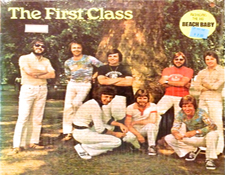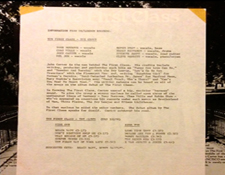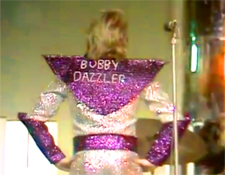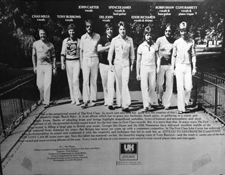It’s the time of year for saving money!
When I was in junior high in the mid-1970s, there was this sort of annoying song being played — seemingly all the time — on the radio that sounded like a cross between the cheesier sides of the Four Seasons and the Beach Boys. I never paid much attention to it but it was all over the airwaves on “AM” pop radio at that time, so it was hard to avoid.
 Years earlier, however, there was a slew of singles on the radio by equally mysterious one-hit-wonder type bands that were undeniably catchy and ultimately got etched into one’s psyche growing up at that time:
Years earlier, however, there was a slew of singles on the radio by equally mysterious one-hit-wonder type bands that were undeniably catchy and ultimately got etched into one’s psyche growing up at that time:
- “Love Grows Where My Rosemary Goes,” by the Edison Lighthouse
- “My Baby Loves Lovin'” by White Plains
- “Gimme Dat Ding” by the Pipkins
- “United We Stand” by the Brotherhood of Man.
The sonic glue between all of these records was their lead singer. It turns out that these bands all had the same lead singer: Tony Burrows.
And yes, he sang lead on that annoying song from 1974: “Beach Baby.”
This group, the First Class, was the brainchild of one John Carter, who scored a 1967 hit with Burrows as the Flower Pot Men (“Lets Go To San Francisco”) and who later went on to be a session singer (according to the Wiki he sang backups on The Who’s “I Can’t Explain” ?!?!).
Recently (at music store or a garage sale somewhere along the way) I picked up a copy of the full album by the First Class, featuring the single “Beach Baby.”
It was a particularly interesting find as albums by these groups were not especially popular sellers. These were singles bands, and in the case of the Edison Lighthouse, an album was never actually made. Just 45 RPM singles (kinda like today when some new artists only issue a single track download vs. a whole collection of songs).
 The other curious thing about finding this actual album by the First Class was that it included the promotional copy (seen in the photo at right), likely intended for radio stations or retailers which the record labels hoped would play this in-store to promote sales.
The other curious thing about finding this actual album by the First Class was that it included the promotional copy (seen in the photo at right), likely intended for radio stations or retailers which the record labels hoped would play this in-store to promote sales.
It was also especially interesting that I found two copies of this album — again, which I’d never seen before — sitting side by side in the bargain bin ($2 each!) in perfect condition. As a fan of all things power pop and bubblegum, I grabbed them knowing I’d not likely see these again anytime soon in this manner.
These copies also included a special bonus: an original press release from the time of the album’s release was physically taped to the back cover (under the shrink wrap, so it was no accident!).
Carefully peeling one of them back, I found that the liner notes under the press release were pretty over the top :
“Banks of wheeling brass and strings highlight magnificent melodies, lyrics of humor and atmosphere, and most importantly the powerful rhythm sound heard for the first time on First Class records.”
Heavy promotional hype for sure that was completely inconsistent with the lighthearted flavor of “Beach Baby.”
I suspect that the press release being scotch taped over the liner notes was thus a quite intentional effort on the part of whomever was assigned the task of trying to publicize and promote this album.
Realize that at that point in time, bubblegum pop was nearly dead, disco was on the rise, hard and progressive rock from the likes of Led Zeppelin and Yes dominated the FM airwaves. At that time, Brian Wilson was still viewed as a casualty of the psychedelic ’60s, yet pockets of musician types certainly knew of and revered his innovations. Phil Spector was virtually in retirement by then. Big Star was wallowing in obscurity. The Raspberries were breaking up. Even with bands like the Ramones and Blondie starting to hit in the late ’70s, it would be six or seven years before a new generation began to rediscover and embrace this type of music. Then new bands like REM and the dBs began to emerge, groups which had started mining some of these pure pop sounds for a new generation of listener.
Anyhow, one thing I’ve learned over the years while exploring many recordings made by studio session musicians (Phil Spector, the Beach Boys, Gary Usher, Curt Boettcher, etc.), these seemingly simple pop music toss-offs are anything but throw-aways. Closer listening often indeed reveals said “banks of wheeling brass and strings….”
So… all that covered-up promotional hype under the press release got me listening to the First Class album in a more serious manner. I quickly discovered that it was produced to be a bit of a concept record: It plays like a radio show, with DJ introductions for many of the songs as if you were listening to radio at the time. (Echoes of the Who’s Sell Out, for certain.)
All of a sudden, that cheesy song “Beach Baby” makes a lot of sense in context with these other tunes.
As an end-to-end listen, it is actually quite fun, with a number of the songs approaching mini pop epic status. Character studies like “Surfer Queen” could be a lost track by influential ’60s surf pop band the Rip Chords (by way of The Raspberries). “What Became of Me” is a quite spectacular homage to Brian Wilson replete with harmony constructs that were common to Beach Boys’ pop symphonies found on Pet Sounds and the (then unreleased) SMiLE album.
]]>Honestly, this track could almost fit on the High Llamas’ Wilson-inspired SMiLE homage Gideon Gaye (issued some 20 years later in 1994)
“Every track will stay in your memory and return to your record player time and time again,” cries the liner notes…
 The press release on the back cover also details that besides “Beach Baby,” the other “suggested cut” (probably for DJ consideration) was a tune tucked away in the middle of side two called “Bobby Dazzler.”
The press release on the back cover also details that besides “Beach Baby,” the other “suggested cut” (probably for DJ consideration) was a tune tucked away in the middle of side two called “Bobby Dazzler.”
Turns out the phrase “bobby-dazzler” is a common British and Australian slang for “a person or thing that is outstanding or excellent.”
Thus, the lyrics to that song take on a bit of ironic twist as it seems to be a tale about a misguided rock’n’roll star. It was not until I found a video promoting the song (on YouTube, from a Top of the Pops BBC appearance by a road version of the group sans Tony Burrows) that I saw it was indeed an homage to a disgruntled semi-failed pop star riding the then popular trend of glitter rock. This video includes a character in a full purple and gold glitter garb from the period.
So, here we are 40-odd years beyond this album’s release and it has a sort of cool undercurrent. I am guessing here, but it sure seems as like these guys knew they were making a sort of tribute concept record to and from the period. Obviously, they couldn’t really promote it as such — they were known for their singles and I’m sure the intent was just to get “Beach Baby” on the airwaves. It became a #4 hit in the US, #13 in the UK and #11 in Australia!
Regardless, the album they left behind bears a surprising amount of love and care put into it for posterity.
Again, in possibly a little tribute to the Who’s Sell Out album (from 1967), I love the final faux radio air check where they are signing off from “Radio 2 MUCH.” As the album ends and the track leads your stylus into the dead wax run out groove, we hear a high pitch squeal ala The Beatles’ Sgt. Pepper (which stops short of having the endless loop audio verite snippet there).
 Meanwhile, the liner notes read: “It is an album which has to grace any barbecue, beach party or gathering in a warm and happy home.”
Meanwhile, the liner notes read: “It is an album which has to grace any barbecue, beach party or gathering in a warm and happy home.”
On the wiki, John Carter is quoted as saying “Making the First Class albums was a very happy and creative time. Who knows if we ever come up with another suitable song, maybe we will all get back together one day and record under that name again?”
The First Class did put out a second album after this one, which I will be looking for…
For now I am glad to own this album as both a curio from the period but also a sort of oddly wonderful tribute to the sort of pop radio some of us heard as kids growing up in the ’60s and ’70s.
Tracks from this record would sit nicely in a playlist or DJ set alongside songs from the Posies, Big Star, the Flame, the Archies, the Raspberries, XTC, the Futureheads, the High Llamas, the Wondermints and many others who have been influenced by this sort of finely honed compositional style.
For me, this First Class album is a keeper. Goofy as it may seem on its shiny white-suited bubble-gummy surface, there are many well-constructed complex riches to be enjoyed within the full album.
There are CD versions of the First Class albums available up on Amazon and if you look around on eBay you’ll find copies of this on vinyl for under $10.
Worth checking out.






